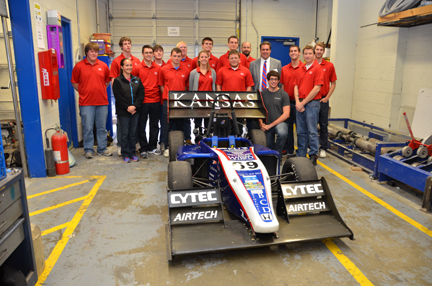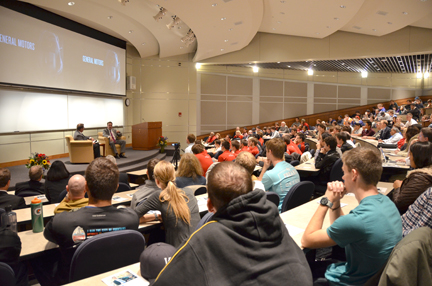GM Exec Gives KU Students the OnStar Treatment

A top General Motors executive told University of Kansas students that listening could be the most important skill an engineering student can bring to the jobsite.
Mark Reuss, president of General Motors North America, spent the better part of a crisp November day touring parts of the KU School of Engineering and talking with students. He delivered the school’s fifth Distinguished Engineering Lecture to a packed crowd of students, faculty and the public.
“No matter how good your idea is or how creative you are, if you don’t listen to what other people, or other engineers, or other business people think of that, it won’t be the best idea, and it won’t be the most creative and it won’t be the most moving thing you could have done.”
His time at KU began with a tour of the new Hill Engineering Research and Development Center and a look at some of the transportation projects under way with the KU EcoHawks student group. He was given an exclusive ride in a 1997 GMC Jimmy the students, under the direction of Associate Professor Chris Depcik, converted to an electric vehicle.

Reuss, who holds a Grand American Road Racing license, also spent some quality time with the Jayhawk Motorsports team. There he learned about the award-winning team’s Formula SAE design and build efforts and saw past and present iterations of the team’s vehicles.
By far the biggest event of the day was the Distinguished Engineering Lecture in Spahr Engineering Classroom. There, in a fireside chat led by Associate Professor Robb Sorem, faculty adviser to Jayhawk Motorsports, Reuss answered a variety of questions from students that ranged from his experiences as an engineering student at Vanderbilt to his involvement in product development and business strategy.
Reuss, who began his career as a mechanical engineer at GM, offered words of wisdom that straddled the breadth of his experiences. When asked about GM’s Chapter 11 reorganization and its effect on the company culture, Reuss was forthcoming.
“It absolutely was a soul-sucking destruction of employee morale for everyone that was there,” he said. “It was quite terrible, because the management story up until the very end was that ‘it’s going to be OK and we’re not going to be bankrupt.’ “

Reuss, who stepped up to his current leadership role in 2009 – at a low point for GM – was able to find a bright spot to the restructuring. There were many employees at GM who were biding their time until retirement, he said. “They weren’t there to win.” The reorganization allowed the company to release unmotivated employees at all levels of the company. When the company was in a position to begin hiring again, it could focus on bringing in fresh talent and people in fields that would be beneficial in the years ahead.
As conditions improved, GM was able to re-establish a racing program that shifted the emphasis from marketing to engineering. The greater focus on performance engineering for Indy Car Racing resulted in benefits for the consumer vehicle market, he said.
“We’ve learned some wonderful things around combustion and fuel injection that we have not been able to see on a regular production car engine. So there have been some great, great fuel economy gains too on the completeness of burn and piston shape and combustion chamber shape that we learned with that program, too, in where to exactly direct our fuel in the combustion chamber.”
The effort also garnered some awards for GM and developed an engineering workforce that takes the gains from racing and transfers that knowledge to production vehicles like the Cadillac CTSV, Corvette or Camaro.

Reuss was able to share some of the technology in the works that drivers will start seeing on the showroom floor, including an enhanced vehicle diagnostics system.
“I think the pipe we’re putting in for OnStar that’s 4G will enable a lot of things in the car. A lot of that has to do with pre-definition of component failure in the car. We’ll be able to look at that through the cloud on a relative basis before it happens. The reliability is going to be changed because of it. I also think that pipe will also really enable us to get at customer attention. Whether it’s sending you the state of your car or scheduling an appointment to do something to your car, it’s going to get a heckuva lot easier and you’re going to have some high barriers to switching out of GM product in the future because of it. “
Students also wanted to know about making a move into management. Reuss was less willing to jump on the climb-the-corporate-ladder bandwagon. Instead, he encouraged students to pursue a field they love and take on new roles when it feels right and makes sense to do so.
“If you come in and it’s something you don’t like to do, that’s a real problem. It will affect the people you love, the people you marry or partner with, your kids. It will affect the way you do your job. It will affect all of it in a very negative way. It will make your life miserable. … The one thing I can really control today is doing my job better than anybody else. That’s all you can really control today. Don’t over-think it. Enjoy what you’re doing, because if you don’t enjoy what you’re doing, you’re not going to be good at it.”